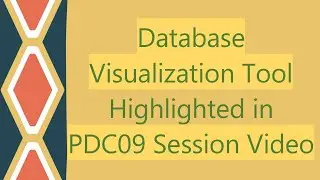What Date Format to Use in SQL Server to Avoid Daylight Savings Issues
Summary: Learn what date format to use in SQL Server to avoid issues with daylight savings time, ensuring accuracy and consistency in your data.
---
Disclaimer/Disclosure - Portions of this content were created using Generative AI tools, which may result in inaccuracies or misleading information in the video. Please keep this in mind before making any decisions or taking any actions based on the content. If you have any concerns, don't hesitate to leave a comment. Thanks.
---
When dealing with dates and times in SQL Server, choosing the right date format is vital to ensure data accuracy and consistency. Particularly, managing daylight savings time (DST) can be a hassle, often leading to unexpected shifts in time calculations. Here's what you need to know to avoid these issues.
The Importance of Date Format
SQL Server offers a variety of date formats, each serving different use-cases. However, when it comes to handling daylight savings time, not all date formats are created equal. Some formats can lead to complications, like time shifting or errors in data operations, if daylight savings adjustments aren't considered.
Recommended Date Format
To handle daylight savings correctly, it is generally advisable to use the ISO 8601 date and time format, YYYY-MM-DD. This format is recognized internationally and is not affected by the cultural settings of your SQL Server instance.
When dealing with datetime or timestamp data types, you can store your time in Coordinated Universal Time (UTC). Using UTC standardizes your time representation and eliminates the discrepancies caused by daylight savings time changes. This is particularly useful in distributed systems spread across different time zones.
Best Practices
Store in UTC: Opt to store datetime values in UTC format. This sidesteps the intricacies of time zone differences and daylight savings variations.
Convert to Local Time as Needed: Convert UTC to the local time zone only when displaying data, be it in application layers or reporting tools. It's easier to handle presentation time changes compared to historical records.
Database Design: Design your tables to include timezone information when it's impossible to avoid different time zones. However, be wary that this approach adds complexity to your database structure.
Testing: Always test your application or database logic against daylight savings time changes. Simulated tests can help identify potential pitfalls in your date handling logic.
Conclusion
By opting for the ISO 8601 format and storing your datetime in UTC, you protect your application from the impacts of daylight savings changes. These practices not only ensure data consistency but also future-proof your systems against time zone irregularities. Make sure to remain vigilant with regular testing and monitoring to catch any unforeseen issues due to time changes.
Avoid the pitfalls of daylight savings and maintain the integrity of your data — your systems' data handling depends on it.































